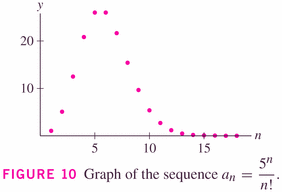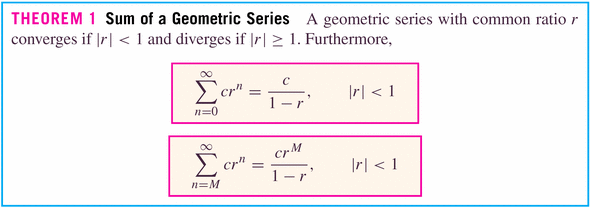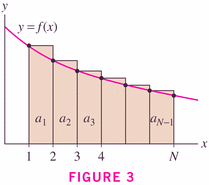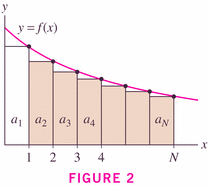- Your next exam is Thursday, and will cover through 11.1.
- 10.4 Homework returned:
- 6
- 22
- 38
- A series joke:
An infinite number of mathematicians walk into a bar. The first one orders a beer. The second orders half a beer. The third order a quarter of a beer. The fourth orders an eighth, and so on.
The bartender says "You're all idiots", and pours two beers.
- Once we have some series in hand, we might want to start operating with them. In particular, as we saw in our very first series, we might want to add up the terms:

We should get
Such a sum is called an infinite series.
- The question which presents itself is this: what do we mean by this sum of an infinite number of terms? This is indeed curious.
- Here's how we make sense of that infinite sum:
- From the sequence
we define a new sequence
:
These are called partial sums. Notice that there are two indices running around, and that the limit refers to the summation's upper limit, not to the index of the sequence.
If
Then we say that
exists, and is equal to
. This justifies our probability distributions of the form
Because, in general,
This is an astonishing fact: we can think of an exponential function as a polynomial with an infinite number of terms. In fact, we can think of lots of functions this way (e.g. sines and cosines!). This is where we're headed in this class....
More formally,

Now geometric series are sufficiently important that it's useful to include that special case:

There's a really fun proof of the first part above, based on a trick. Let's have a look at it, when
:
Multiply both sides by r, subtract, and solve for S.

This theorem tells us that if a sequence isn't asymptotic to the x-axis, if the terms don't tend to 0, we can forget about its sequence of partial sums converging.
Finally, series behave the way we'd hope:

- Examples:
- The harmonic series (Example 8, p. 732)
- #1, p. 735
- #2
- #4
- #15
- #17
- #61
- #87
- Beautiful spiral "proofs" of some infinite series
- From the sequence
- Section 11.3: The Integral Test
- concerns several different means of testing for convergence of
series with all positive terms (obviously, if we're dealing with series
of all negative terms, similar results are going to apply).
- We're not so concerned with the actual limits (that is the values
of the series) as we are with the convergence (or divergence) of the
series.
- Theorems:




Theorem 3 is just a corollary of Theorem 2, where the integrals are the obvious power functions:

Let
, where f is a positive, decreasing function. If
converges by the integral test, and we define the remainder by
, then
(this gives us a bound on the error we're making in the calculation of a series). This is useful, for example, in the calculation of digits of
(now, you might ask "and what's the use of that?!";).
- Examples:
- We can use this method to demonstrate conclusively that the harmonic series is non-convergent.
- Dominoes (here's my page) -- and here's a more elegant page in Mathematica: Divergence of the harmonic series (and dominoes!)
- #22
- #36
- concerns several different means of testing for convergence of
series with all positive terms (obviously, if we're dealing with series
of all negative terms, similar results are going to apply).